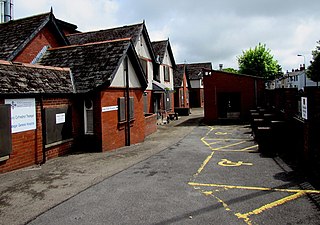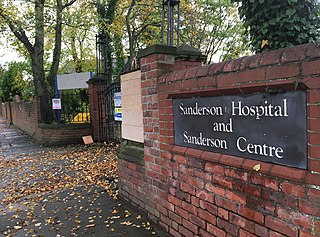Related Research Articles

Aneurin "Nye" Bevan PC was a Welsh Labour Party politician, noted for tenure as Minister of Health in Clement Attlee's government in which he spearheaded the creation of the British National Health Service. He is also known for his wider contribution to the founding of the British welfare state. He was first elected as MP for Ebbw Vale in 1929, and used his Parliamentary platform to make a number of influential criticisms of Winston Churchill and his government during the Second World War. Before entering Parliament, Bevan was involved in miners' union politics and was a leading figure in the 1926 general strike. Bevan is widely regarded as one of the most influential left-wing politicians in British history.
An NHS foundation trust is a semi-autonomous organisational unit within the National Health Service in England. They have a degree of independence from the Department of Health and Social Care. As of March 2019 there were 151 foundation trusts.
An NHS trust is an organisational unit within the National Health Services of England and Wales, generally serving either a geographical area or a specialised function. In any particular location there may be several trusts involved in the different aspects of providing healthcare to the local population. As of April 2020 there were altogether 217 trusts, and they employ around 800,000 of the NHS's 1.2 million staff.

Rhymney is a town and a community in the county borough of Caerphilly, South Wales. It is within the historic boundaries of Monmouthshire. With the villages of Pontlottyn, Fochriw, Abertysswg, Deri and New Tredegar, Rhymney is designated as the 'Upper Rhymney Valley' by the local Unitary Authority, Caerphilly County Borough Council. As a community, Rhymney includes the town of Rhymney, Pontlottyn, Abertysswg, Butetown and Twyncarno.

Tredegar is a town and community situated on the banks of the Sirhowy River in the county borough of Blaenau Gwent, in the southeast of Wales. Within the historic boundaries of Monmouthshire, it became an early centre of the Industrial Revolution in Wales. The relevant wards collectively listed the town's population as 15,103 in the UK 2011 census.

NHS Scotland, sometimes styled NHSScotland, is the publicly–funded healthcare system in Scotland and one of the four systems that make up the National Health Service in the United Kingdom. It operates 14 territorial NHS boards across Scotland, supported by seven special non-geographic health boards, and Public Health Scotland.

Bedwellty is a small village in Caerphilly County Borough in south Wales. The village stands on a ridge of high ground between the Rhymney and Sirhowy valleys. The village comprises St Sannan's parish church, public house and a few houses. The register of St Sannan's Church dates from 1624, which qualifies Bedwellty as an ancient parish. Historically the parish lay in the county of Monmouthshire, the hundred of Wentloog, Tredegar County Court District, the rural deanery of Bedwellty, the archdeaconry of Monmouth and the diocese of Llandaff. Several towns based on the iron industry expanded within the parish boundary, including from west to east, Rhymney, Tredegar and Ebbw Vale, which gradually gained administrative independence from Bedwellty between the 1870s and 1890s. A Bedwellty Local Government District was established for the rest of the parish in 1891, becoming an urban district in 1894.
Gwent Healthcare NHS Trust was an NHS Trust in South East Wales.

Tredegar General Hospital was a community hospital in Tredegar, Blaenau Gwent, Wales. It was managed by the Aneurin Bevan Local Health Board.

The National Health Service Act 1946 came into effect on 5 July 1948 and created the National Health Service in England and Wales thus being the first implementation of the Beveridge model. Though the title 'National Health Service' implies a single health service for the United Kingdom, in reality one NHS was created for England and Wales accountable to the Secretary of State for Health, with a separate NHS created for Scotland accountable to the Secretary of State for Scotland by the passage of the National Health Service (Scotland) Act 1947. Similar health services in Northern Ireland were created by the Northern Ireland Parliament through the Health Services Act 1948.

Trefil is a small village in the county borough of Blaenau Gwent, south Wales. It lies at the top of the Sirhowy Valley, near to Brecon Beacons National Park. It is three miles northwest of Tredegar. With one public house, The Top House, serving homemade food and drinks to local visitors.

Aneurin Bevan University Health Board (ABUHB) is the local health board of NHS Wales for Gwent, in the south-east of Wales. Headquartered in Caerleon, the local health board (LHB) was launched in October 2009 through the merger of Gwent Healthcare NHS Trust and Blaenau Gwent, Caerphilly, Newport, Torfaen, and Monmouthshire LHBs. It is named after Aneurin Bevan, a Member of Parliament who represented the area and who was the Minister of Health responsible for the foundation of the National Health Service. Aneurin Bevan University Health Board is the operational name of Aneurin Bevan Local Health Board.
The Sirhowy Tramroad was a plateway built to convey the products of ironworks at Tredegar to Newport, South Wales. It opened in 1805 between Tredegar and Nine Mile Point, a location west of Risca, from where the Monmouthshire Canal Company operated a tramroad to Newport. The Sirhowy Tramroad was operated at first by horse traction, but early locomotives were used, and a passenger service was operated.

Tredegar Medical Aid Society was founded in Tredegar in South Wales. In return for contributions from its members it provided health care free at the point of use. This society contributed the model which established the British National Health Service. According to Colin Ward, the model had "evolved from the vast network of friendly societies and mutual aid organisations that had sprung up through working class self-help in the 19th century."

The Health and Social Care Act 2012 is an act of the Parliament of the United Kingdom. It provided for the most extensive reorganisation of the structure of the National Health Service in England to date. It removed responsibility for the health of citizens from the Secretary of State for Health, which the post had carried since the inception of the NHS in 1948. It abolished primary care trusts (PCTs) and strategic health authorities (SHAs) and transferred between £60 billion and £80 billion of "commissioning", or healthcare funds, from the abolished PCTs to several hundred clinical commissioning groups, partly run by the general practitioners (GPs) in England. A new executive agency of the Department of Health, Public Health England, was established under the act on 1 April 2013.
Healthcare in London, which consumes about a fifth of the NHS budget in England, is in many respects distinct from that in the rest of the United Kingdom, or England.

Nantybwch railway station was a station on the London and North Western Railway's Heads of the Valleys line serving the village of Nantybwch in the Welsh county of Monmouthshire.
The Bedwellty Union Workhouse was situated in Georgetown, Tredegar. It is 2.9 miles (4.7 km) from the Nanybwtch Junction A465. The building was in existence for approximately 127 years. The workhouse building was also used as a hospital. Today, the site where the building once stood, there is a housing estate known as St James Park.

Sanderson Hospital was an orthopaedic hospital for children and an elderly care facility used by the NHS in Gosforth, Newcastle upon Tyne, UK.
References
- ↑ "History of the NHS in pictures". Socialist Health Association. Retrieved 13 November 2013.
- ↑ Rivett, Geoffrey (1998). From cradle to grave: fifty years of the NHS (repr ed.). London: King's Fund. ISBN 978-1-85717-148-8.
- ↑ Webster, Charles (1988). The Health Service since the war. HMSO. ISBN 0 11 630942 3.
- ↑ "Annual report : 1949 / Rhymney and Sirhowy Valleys Hospital Management Committee". Wellcome Collection. Retrieved 15 July 2024.